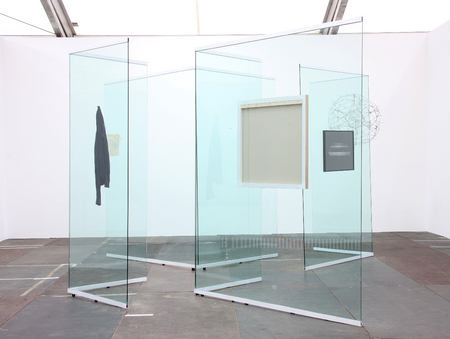UMMA hosts installation peeking into the 'Brain' of Simon Dybbroe Møller

"Brain"
photo courtesy of the University of Michigan Museum of Art
One museum is not enough for Denmark’s Simon Dybbroe Møller.
Indeed, two museums may not be enough either, based on the appearance of this celebrated “rational mystic’s” quirky University of Michigan Museum of Art installation “Brain II-V.”
UMMA Associate Curator of Modern and Contemporary Art Jacob Proctor tells us in his introduction to the exhibit (in the museum’s adventurous Irving Stenn Jr. Family Project Gallery), “Møller’s penchant for puzzles and paradoxes reflects his interest in modernism’s theoretical aspirations as well as its practical failings.
“The installation stems from a scenario invented by the artist, of an art museum on whose transparent walls its entire collection is displayed simultaneously, without regard for any apparent conceptual, thematic, or chronological order.
“This fantasy,” he concludes, “is ultimately an allegory for the mind of the artist himself.” This marvelous allegorical inventiveness accounts for the out-of-the-ordinary appearance of Møller’s installation.
“Brain II-V” consists of 15 Plexiglas partitions spread about in a maze through the Project Gallery, where sundry objects (abstract paintings; a hanging jacket; a potted plant; a waste basket filled with crumpled photographs; stacked empty boxes) are either nailed or heaped in artless clutters.
As Proctor says, there’s seemingly no “conceptual, thematic, or chronological order” to these objects. They all merely occupy one niche or another in the scheme of Møller’s “Brain.”
There are, of course, many ways our mental processes can potentially be conceptualized. It’s a common enough conceit in literature for an author to adopt a stream-of-conscious omnipotence. The 20th century surrealists sought to craft art that suggested abnormal mentalities, and ambient music seeks to drift along in transcendent cadences.
Proctor is right, therefore, in drawing our attention to Møller’s conflicted preoccupation with modernism: There’s certainly “puzzles and paradoxes” in “Brain II-V” that reflect “modernism’s theoretical aspirations as well as its practical failings.” His preoccupation with the past and future is hidden in his “Brain’s” plain sight.
Previously mounted in Copenhagen, New York, and Berlin, this UMMA version is a special event. Walking through the gallery, we’re forced to travel in nonlinear patterns only to end up against diaphanous walls confronted with detritus or other objects with an ambiguous aesthetic function.
Møller’s chambers therefore serve the same cognitive purpose as an odor, piece of music, or visual cue, jarring us down memory lane or thrusting us to an undetermined future.
We’re walking through Møller’s brain. And what a fascinating trip it is.
Different paths may lead to the same memory. Walk around the installation long enough and its byways establish an internal consistency. Peer through the glass while moving and these elements ultimately build a tangible unity that fuses one image with another.
It's art of an extraordinarily rarefied sort — wedded both to the physical world and to conceptual whimsy. Møller’s “Brain II-V” is ultimately well worth the walk, the wandering back and forth, time and time again.
“UMMA Projects: Simon Dybbroe Møller ‘Brain II-V’” continues through February 13 at the University of Michigan Museum of Art, 525 South State Street. Museum hours are 10 a.m. to 5 p.m., Tuesday-Saturday; and noon to 5 p.m., Sunday. For information, call 734-763-UMMA.
John Carlos Cantú is a free-lance writer who reviews art for AnnArbor.com.

